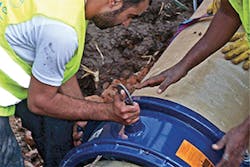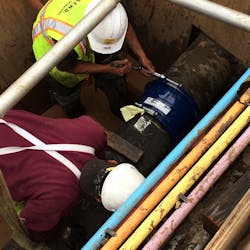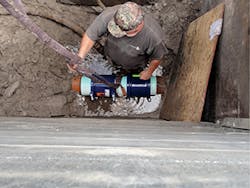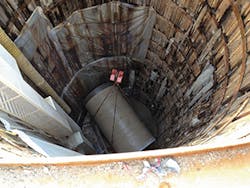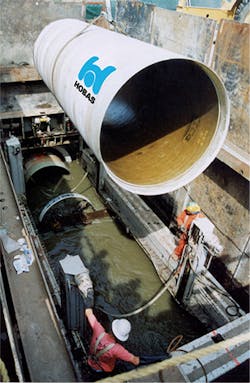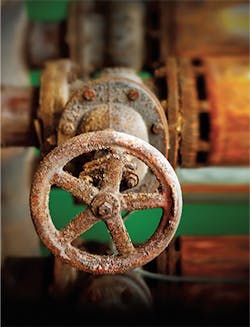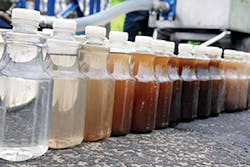The age of our country’s infrastructure is the number one cause of leaks, states Ed Nunes, product manager for Krausz USA. When repeated breaks occur on a line, it may signal that the line needs to be replaced. However, many municipalities and water utilities have budgetary restraints; even as their infrastructure deteriorates, they may struggle to allocate sufficient funds for replacement.
Doug Riseden, technical support manager for Krausz USA, writes in “When to Repair or Replace Pipe” that repeated repairs may undermine the benefit of a lower short-term cost, particularly when the cost of parts and labor, as well as the expense of closure and service interruptions during the repair, are included in the calculation.
“No one is doing straight replacement,” says Matthew Stephenson, director of water utilities and technical services UK, Suez. Very little “open-cut, remove, and replace” is happening. “Rehab is the norm.”
Although water loss is a “major problem” and replacement is the solution, Stephenson says it isn’t occurring often because “there’s no money for that.” Instead, utilities and municipalities are “getting more from the infrastructure because there’s no money to replace it.” Capacity may remain high in some areas that are water-stressed. However, lowering the volume to decrease usage creates other problems.
Most pipes were designed 50 years ago or more. “Are they still fit?” asks Stephenson. Age, environment, and climate take their toll. “The water industry is not built around extremes,” he cautions, explaining that severe cold in the UK last winter resulted in many burst pipes, just as a near-record-hot summer created higher demand for water.
Each system or method has a purpose, Rosenberg acknowledges. Successful rehab methods depend on a variety of factors, such as:
- location (rural; urban; near businesses; under buildings, railways, rivers, or other utilities);
- diameter and length of the accessible section;
- lead time of materials and timeframe of the job;
- disruption to local businesses and residents; and
- season and temperature.
Portable cured-in-place pipe liners for pressure pipes are most effective for potable water and force main applications from 6–48 inches in diameter. “They are typically composite materials made up of fiberglass, felt, and a waterproof membrane,” details Rosenberg. A small construction footprint, short lead time, and low impact to local businesses and residents combine to make this an attractive option when compared with open-cut replacement of water and force mains.
Carbon fiber wrap is often more expensive than CIPP, but the pressure capabilities are higher and the product can rehabilitate larger pipes, ranging in diameter from 36–201 inches. “This structural solution is comprised of carbon fiber sheets and high-performance resin systems that are hand-applied into place on the pipes to form a very strong and pressure-capable rehabilitated pipe,” says Rosenberg.
Geopolymer is another solution for larger diameter pipes (36–100 inches or greater). The material is applied by spraying it onto the host pipe. The thickness is designed for each application.
UV lining systems use a CIPP liner with a unique resin cured inside the host pipe by UV light trains instead of water or steam, Rosenberg says. “UV curing is desirable in environmentally sensitive areas such as rivers, streams, and outfalls and with municipalities that have adopted ‘green-friendly’ products for the rehabilitation of their pipeline systems.”
REPAIR
When a large sinkhole developed in the South of Market neighborhood of San Francisco—a very densely populated area with heavy traffic—the Water Department and High Pressure Fire System for the city’s public utilities commission needed to quickly repair the piping in order to restore water service so that street-level traffic could resume. The department provides water services to the 2.6 million residents in the greater Bay Area and manages retail drinking water for San Francisco and wholesale water for three Bay Area counties.
Underground digging on subway tunnels triggered the sinkhole, which measured 50 feet wide, 75 feet long, and 40 feet deep. The falling debris damaged the cast iron pipe that was originally installed almost 100 years ago, exposing the pipe and leaving the utility lines channeled alongside the piping unsupported, putting additional pressure on the pipe.
The piping ran between a number of concrete utility vaults and had a pressure rating of 300 psi. A coupling was required that could safely handle the high water pressure so that entire lengths of piping between the vaults wouldn’t have to be replaced. Typically, it would involve connecting the pipes with lead joints, which is time-consuming and labor-intensive, not to mention expensive.
Richard Gonzales, superintendent of construction, maintenance, and operations, chose the 12-inch HYMAX coupling for its 350 psi pressure rating. Instead of having to remove and replace six lengths of cast iron pipe, the crew was able to replace only the damaged sections with new sections of pipe connected on either side with HYMAX couplings. This reduced the time from weeks to a matter of days.
One reason for the shortened timeframe was that the HYMAX coupling eliminated the need to remove and replace lengths of pipe between the vaults. “I could not find any other coupling that could handle the high water pressure,” says Gonzales. “The HYMAX offered the strength necessary to make the repair. Without it, labor costs would have skyrocketed, paving material costs would have tripled, and we might have had to de-energize power lines, causing disruption for businesses in the area.”
Another reason installation was so quick was that it was easy. The HYMAX coupling features two (fewer than most traditional couplings) top-facing bolts that are easy to secure, particularly in an application like this where there’s little space for bolt connections.
Faster installation is safer, particularly for night repairs near traffic, and cheaper. “It saves labor, tools, and equipment because there are only two bolts versus 20,” says Nunes, product manager, Krausz USA.
“The number one selling point is ease of installation: the two-bolt process,” continues Nunes. “It saves time in repair and reduces the amount of inventory required because it can transition from one to another type of pipe.” It can be used on any common pipe, he says—PVC, ductile iron, asphalt cement, cast iron, steel—in sizes of 1.5 inches to 70 inches.
An additional benefit of the HYMAX coupling is the patented two-stage gasket with four degrees of dynamic deflection on each side that allow pipes to shift while maintaining a tight seal. Because the Bay Area is subject to occasional seismic activity, this “shock absorber” effect is important because it helps pipes withstand the stress caused by ground movement. “It moves independently of the pipeline,” explains Nunes. “It moves with the soil like a shock absorber to prevent new leaks.”
INNOVATIONS
Innovations at Krausz are the result of feedback from the customer and the utilities, Nunes says. “We address their pain points.” Needs are different across the country because of soil type, climate, and population. In the Pacific Northwest, for example, corrosive soils deteriorate pipe. A different type of gasket is commonly used in Texas, he says, than in the north, where freeze/thaw cycles are the norm, or in urban areas where pipes are close together.
The HYMAX 2 gasket “flips out” to accommodate a connection of larger diameter pipes, different types of pipes, or pipes with different outside diameters, using the same coupling. Nunes describes it as a gasket inside a gasket.
New this year at Krausz is the swivel joint. “If the line breaks, you have to set the angle for the coupling,” explains Nunes, adding that 45 and 90 are the most common angles. If a different angle is needed, you have to use multiple pieces to achieve it. Now, with the 0- to 90-degree swivel joint, one piece can do the job for a speedy repair—saving money on multiple products. He advises keeping one on the shelf for emergencies.
When pipes deteriorate, it’s often the joints in the distribution systems that go first. Distribution systems typically start at 40 inches and reduce to 2 inches, so it’s no surprise that the joints wear out. Replacing them can be difficult, so Krausz designed restraint couplers with teeth. They can grip sizes from 8–16 inches.
GETTING INTO IT
There’s another way to perform joint repairs. They can be sealed with the HydraTite internal joint seal. It’s an internal joint sealing system that offers customized mechanical remediation without expensive excavation. The system consists of a rubber gasket held in place by stainless steel retaining bands. The seals can be interlocked to span long lengths of pipe and can include a backing plate to cover larger gaps and holes.
“It’s a mechanical, trenchless method,” proclaims Alex Sutter, sales manager, HydraTech Engineered Products, which engineers, manufactures, and installs wastewater, oil, gas, and potable water pipes for power plants, municipalities, storm sewers, drains, and more. It's appropriate for pipe joint repairs, pressure pipe repairs, and joint infiltration in drinking water, storm drain sewer, gas pipelines, storage pipelines, distribution pipelines, and power generation pipelines, Sutter says. “We’re pipe people. We can fix any type of pipe we can get into; HDPE, corrugated metal, concrete…anything 18 inches and up. We just have to find an access point and send someone in.”
Sutter calls it a mechanical application and says, “If you can change a tire, you can do this.” Typically, two people using hand tools perform the repairs, putting a wedge behind the stainless steel expander like a hand jack.
With a pressure rating of 3,000 psi, HydraTite is available in three widths, including extra-wide up to a 2-inch offset for dropped pipe or pipe that is not aligned, and double wide for a 5-inch offset. “If the pipe shifts—maybe as a result of freeze/thaw cycles—the rubber shifts with the pipe…as opposed to chemical grouting,” says Sutter.
He believes the HydraTite products compare favorably with chemical grouting. It doesn’t require curing time, whereas when using chemical grouting, the pipe has to be taken out of service while it cures in place. In addition, the initial cost is only 10% higher, but inspection costs are $30 per year versus chemical grouting inspection costs of $130. With a design life of 50 years, Sutter estimates that it saves $7,000 over its lifetime due to service costs. “Chemical grouting barely lasts five years. Two to three is typical.”
Not only does Sutter believe HydraTite is better than chemical grouting, but he also considers it superior to its competitors. There are four ribs on the seal; the competitor’s has three. It’s concave versus convex, with two points of contact versus one.
The City of Houston recently completed a 1,000-seal installation in 30-inch and 36-inch pipeline. “It’s good for point repair,” explains Sutter, “but not a structural repair. Slip-lining is for structural repairs, but it’s costly.”
SLIPPING THE LINE
Slip-lining—trenching to an existing pipe, cutting it away and peeling it back, dropping in a new pipe, pushing that down, and filling in with grout—is a pipe repair procedure typically used on corroded metal, concrete, or brick pipes when digging up the entire area is undesirable.
Although some agencies choose other technologies, slip-lining is a tried-and-true structural method of rehabilitating pipes that protects the surrounding infrastructure by providing leak-free connections and typically maintains or even increases the capacity of the sewer.
“The technology has been out there a long time, but not everyone is aware that you don’t lose capacity through slip-lining,” observes Vince Paparozzi, sales manager for Hobas Pipe USA. He says it’s possible to use pipe up to 13% smaller than the host/existing line and still recover full capacity, although 10% is typical, depending on the pipe’s diameter.
A deep tunnel in Milwaukee, WI, was lined in August 2017 to preserve the integrity of the pipe. The City of Milwaukee Department of Public Works specified CIPP and slip-lining to rehab existing sewers. To preclude future questions about the ability of the lining process to retain the flow conveyance capacity, Hobas hired a third-party to place flow monitors on the repair project consisting of 120 inches of rough and deteriorating brick and concrete pipes in order to document that it maintained original flow capacity.
The 2017 project required their largest diameter pipe: 126 inches. It was fit into the 144-inch existing pipe because, Paparozzi explains, approximately 5% of the diameter is needed around the pipe for annual space grouting.
The host pipe had an inside diameter of 120 inches. It was lined with a 110-inch inside diameter Hobas Pipe liner, resulting in a 10-inch loss of diameter. Nevertheless, Paparozzi reveals, “We increased the flow from 575 mgd to 650 mgd.”
The reason for that increase in flow is that the diameter of a pipe is not the only factor affecting a pipe’s ability to convey a given amount of flow. The ability to convey flow is not only affected by the size of the pipe, but also by the slope of the pipe and its roughness. In free-flowing (flow by gravity) conditions, Manning’s Equation can be used to predict the roughness and resulting capacity of pipes. Manning’s Equation is an empirical equation that applies to uniform flow in open channels and is a function of the channel velocity, flow area, and channel slope.
Due to the nature of the lining process, any lined pipe will have a smaller diameter than the host pipe once the lining is completed. In order to maintain capacity during a lining project, it is important to install a liner that has a significantly smoother flow surface than that of the host pipe. By installing a smoother liner, the effects of friction on the flow are decreased; consequently, the maximum capacity of the lined pipe may be equal to or, in some cases, greater than that of the pre-lined host pipe.
Hobas hired RJN Group Inc. to conduct a study using Manning’s Coefficient to assess the capacity of a deep tunnel sewer before and after the lining installation and to understand the effect of lining the large-diameter sewer on the sewer’s maximum flow capacity. Using ADS Flowshark Triton meters and flow monitors equipped with a submerged area/velocity probe and a crown-mounted ultrasonic probe, depth measurements were taken via a pressure sensor and an up-looking ultrasonic sensor while also measuring peak velocity.
Flow monitoring by RJN Group revealed that the lined section of pipe had a clear reduction in the Manning’s Roughness Coefficient. In this location, the data indicated that the coefficient went from a pre-lined 0.015 to a post-lined 0.010. This significant decrease in roughness actually increased the Manning’s maximum flow capacity of the pipe, from 575 mgd to 650 mgd, despite decreasing the diameter by 10 inches.
In Milwaukee, the host pipe was made of brick, which is known to have a rough surface. After lining with the Hobas pipes, the surface was smooth. The Manning’s Coefficient Analysis proved that the Hobas Liner significantly reduced the roughness of the pipe after installation. In fact, through scattergraph analysis, it can be deduced that the decrease in roughness was so significant that flow capacity at each location actually increased despite the reduction in diameter from a 120-inch to 110-inch pipe. The decrease in roughness correlates to an increase in maximum flow.
In addition, the upstream meter location also indicated evidence of increased flow conveyance capacity despite being upstream of the actual lined pipe. This can be explained by the fact that consecutive pipes act as one continuous composite; therefore, the whole “run” of pipe will be affected by the rehabilitation.
SLIP SAVINGS
Slip-lining can be an economical option. Because it lasts 100 years, it saves utilities from having to do a full replacement for a long time. Made of glass-fiber-reinforced polyester resin and sand, the fiberglass material is resistant to corrosion, extending its lifespan. “Some of the existing lines we rehab are less than 50 years old,” points out Paparozzi.
Cost is a factor, which is why some companies use CIPP or other less expensive methods. One disadvantage of other methods is that the result is not smooth. CIPP applications take the profile of the existing pipe, so it can pick up creases, furrows, or other deflections. “Ours is smooth and consistent,” says Paparozzi, pointing out that it becomes more economical on large-diameter pipes or if there are a lot of deflections to deal with.
Another advantage is that a repair can be completed without bypassing the existing flow—in other words, “live.” That avoids several environmental issues and saves costs by placing piping on the surface, creating a bypass, and curing in place.
Although slip-lining is cost-competitive, many municipalities and engineers worry about losing flow capacity. It’s a difficult notion to dispel, Paparozzi says. “However, having performed the flow analysis, we can now show that capacity can indeed be increased by slip-lining.”
THIS LITTLE PIGGY…
A different method that is sometimes used on drinking water pipes before more invasive procedures is ice pigging. “Ice pigging removes problems from the pipe,” says Matthew Stephenson, director of water utilities and technical services UK, Suez. The technique is proven to effectively remove sediment and biofilm without causing damage to the pipe wall and is more cost-effective than flushing. “It’s not a rehab. There’s no harsh scraping of the inner surface of the pipe. It’s a gentle wiping like with a cloth to remove contaminants and blocks in the pipe.”
An ice slurry is injected into the pipe using a fire hydrant, Stephenson explains. It is propelled through the pipe by pressure, collecting sediment and biofilm along the journey. “It cleans like a solid,” says Stephenson, but it’s a low-risk and quick operation. For deteriorating or fragile cast-iron and concrete pipes, the consistency of the ice slurry can be adjusted to prevent further damage. “We’re very careful with old, fragile pipes.”
Pigging costs significantly less than the alternative method of flushing and uses one-quarter of the water to pick up debris—specifically, sediment, biofilm, and algae. When sediment accumulates and bacteria grows, it changes the chemistry of the water, Stephenson explains.
Two elements accumulate as a result of poor filtering or as a result of deterioration of the drinking water network: iron and manganese. “You can filter them out,” says Stephenson, “but it’s not done because there’s no health risk.”
Biological growth—what Stephenson refers to as “algae and little creatures”—on the inside surface of the pipe is the result of water with high manganese or aluminum content, usually found in parts of the world that don’t chlorinate water.
The substances can be different in the industrial sector, where ice pigging is used to improve efficiency and reduce water costs. Debris from the pharmaceutical and food industries is easily removed from the pipes. Stephenson also mentions a major hair product manufacturer that used to use 369 gallons at 176°F for every cleaning of the machines (up to 20 times a day). “Sticky hair care products are difficult to remove.” The manufacturer now uses 15 gallons of ice to achieve the same results. “It’s a major reduction in water consumption.”
Reducing water consumption during rehab and repair, and reducing water loss through leaky or broken pipes, is the goal. The best method depends on factors ranging from geographical location and weather to budgetary restrictions and type and condition of the pipe.
